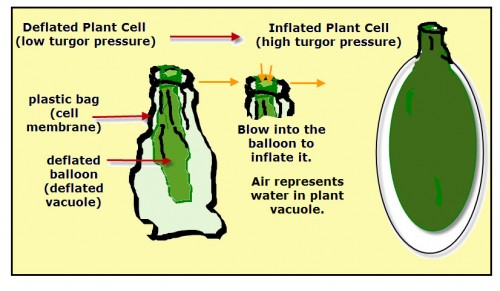The leaves of the Mimosa plant in the video close when touched. Even wind triggers leaf closing. This fast plant movement is not a growth movement, instead it is due to changes in cell turgor pressure.
Turgor pressure in plant cells is due to the amount of water inside water storage areas called vacuoles. The wilting of plant leaves is due to a loss of water resulting in a decrease of cell pressure, called turgor pressure.
Discover for Yourself!
You can model turgor pressure using a balloon and a plastic bag, such as used to hold fruits and vegetables at the grocery.
The plastic bag represents a plant cell. The balloon represents a vacuole inside the plant cell. When the cell vacuole is “deflated,” meaning it is not full of water, and like the deflated balloon and bag, the cell is reduced in size and its shape is erratic.
Each Mimosa leaf is attached to the mid-rib of the leaflet by a pulvini, which is made of cells that can rapidly gain or lose water. This rapid inflation and deflation of the vacuole in each cell results in the opening and closing of the leaves as well as the raising and lowering of the leaves.
Chemical messengers called “Turgorins” give the command for the vacuoles of pulvini cells to take in water and release water. These water changes results in an increase and decrease respectively.
Science Challenge: What other stimuli causes fast plant movement?
 For other science challenges, check out “Super Science Challenges.”
For other science challenges, check out “Super Science Challenges.”
